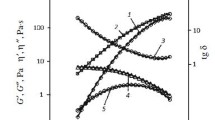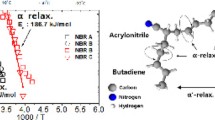Abstract
Nuclear magnetic resonance combined with extension of the specimens in the NMR spectrometer on the reversible deformation range has been used to study the cooperative modes of motion of the macromolecules in polymers, specifically polycaprolactam and polyethylene terephthalate. For each of these polymers there are two temperatures near which the nature of the molecular motion changes sharply. At low temperatures there is a transition from independent hindered vibrations of the repeating units to correlated vibrations, as a result of which the chains in the amorphous regions acquire limited kinetic flexibility within the glassy state; at high temperatures there is a transition to segmental motion. The question of how changes in the modes of molecular motion are reflected in the macroscopic mechanical properties of polymers is examined.
Similar content being viewed by others
Literature cited
V. A. Kargin and G. L. Slonimskii, Brief Outline of Polymer Physicochemistry [in Russian], Moscow (1967).
Yu. S. Lazurkin, "Mechanical properties of polymers in the glassy state," Author's Abstract of Doctoral Dissertation, Moscow (1954).
N. G. McCrum, J. Polym. Sci.,34, 355 (1959).
R. F. Boyer (editor), Transition and Relaxations in Polymers, Wiley (1966).
N. N. Peschanskaya and V. A. Stepanov, Fiz. Tverd. Tela,7, 2962 (1965).
V. V. Korshak and T. M. Frunze, Synthetic Heterochain Polyamides [in Russian], Moscow (1962), p. 334.
F. Stehling and L. Mandelkern, J. Polym. Sci.,B7, 255 (1969).
E. A. Egorov, N. N. Peschanskaya, and V. A. Stepanov, Fiz. Tverd. Tela,11, 1325 (1969).
I. Ya. Slonim and A. N. Lyubimov, Nuclear Magnetic Resonance in Polymers [in Russian], Moscow (1966).
S. N. Zhurkov and E. A. Egorov, Dokl. Akad. Nauk SSSR,152, 1155 (1963).
E. A. Egorov and V. V. Zhizhenkov, Fiz. Tverd. Tela,8, 3583 (1966).
E. A. Egorov, "Molecular motion in mechanically loaded polymers," Author's Abstract of Candidate's Dissertation, Leningrad (1968).
É. E. Tomashevskii, E. A. Egorov, and A. Ya. Savostin, Pribory i Tekh. Éksperim., No. 3, 156 (1966).
I. M. Ward, Trans. Farad. Soc.,56, 648 (1960).
V. S. Kuksenko and A. I. Slutsker, Fiz. Tverd. Tela,10, 838 (1968).
A. I. Gubanov, Mekhan. Polim., No. 1, 143 (1966).
E. A. Egorov and V. V. Zhizhenkov, Vys. Molek. Soed.,A10, 451 (1968).
S. E. Bresler and Ya. I. Frenkel', Zh. Éksperim. i Teor. Fiz.,9, 1094 (1939).
A. I. Maklakov, G. G. Pimenov, and V. I. Shepelev, Vys. Molek. Soed.,7, 1894 (1965).
G. L. Slonimskii, A. A. Askadskii, and V. V. Kazantseva, Dokl. Akad. Nauk SSSR,185, 371 (1969).
V. A. Kargin and T. I. Sogolova, Zh. Fiz. Khim.,27, 1039 (1953).
Additional information
Ioffe Physicotechnical Institute, Academy of Sciences of the USSR, Leningrad. Translated from Mekhanika Polimerov, No. 1, pp. 24–29, January–February, 1971.
Rights and permissions
About this article
Cite this article
Egorov, E.A., Zhizhenkov, V.V. Relation between the mechanical properties of polymers and the kinetic flexibility of the macromolecules. Polymer Mechanics 7, 21–25 (1971). https://doi.org/10.1007/BF00856610
Received:
Issue Date:
DOI: https://doi.org/10.1007/BF00856610




